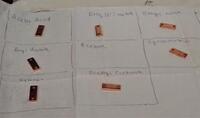TURI Lab's Basic Procedure for Product Evaluations
TURI Lab TESTING PROCESS
Coupon Testing
Coupons, also known as panels, are usually rectangular (approx. 2"x 4"), flat sheets matched to a particular part's materials of construction, for example, stainless steel, ceramic or glass. Coupons are number-etched for identification.
Coupon testing is performed to determine optimal cleaning conditions without wasting parts. This testing is conducted in triplicate (minimally) and consists of:
Step 1. Initial weighing of pre-cleaned coupons by means of an analytical balance (wt. - 0.0001 g)
Step 2. Applying the appropriate contaminant (oil, grease, wax, etc.) to the surface of the coupons with a hand-held swab as consistently as possible. Contaminants are soils collected from client's manufacturing process and applied according to client's soil loading.
Step 3. Re-weighing the artificially-contaminated coupons under the same conditions as Step 1.
Step 4. Perform the cleaning trial (entails the primary elements of cleaning such as time, agitation, concentration and temperature, collectively known as TACT) based on client supplied information
Step 5. Final and third weighing of cleaned coupons under the same conditions as Step 1.
Typically the SSL operates using the following TACT conditions during initial testing when no specific information is provided to us from the client:
Time: 5 minutes
Agitation: Immersion with stir bar agitation
Concentration: 5% by volume diluted with DI water
Temperature: 130 F
For these experiments, a 500mL Pyrex beaker of the cleaning solution is prepared according to the vendor's specifications and brought to the recommended temperature on a hot plate with stir bar agitation. The contaminated coupons are then suspended in the beaker and removed after a preset time interval. This procedure minimizes the mechanical energy supplied during the trial in order to reveal differences in cleaning efficiencies for chemical cleaners based on chemical activity rather than agitation.
GRAVIMETRIC ANALYSIS, BEFORE AND AFTER CLEANING
The following information is used to calculate the efficiency of a chemical cleaner:
| Initial Weight: | A |
| Dirty Weight: | B |
| Cleaned Weight: | C |
| Initial Contaminant Weight: | D = B-A |
| Remaining Weight: | E = C-A |
| Percent Removal: | F = (D-E)/D x 100 |
Averages are obtained for the three coupons by adding the results for each of the categories A-F.
Testing of Client Supplied Parts
The lab continues with more detailed testing for promising chemicals with specific cleaning equipment, genuine parts and other surface inspection techniques, depending on the request for technical assistance.
